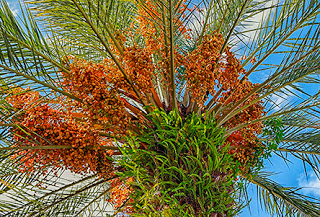Properties of the Date and nutritional composition
The date palm belongs to the Arecaceae family and its scientific name is Phoenix dactylifera L. Its origin is unknown, but it is probably native to North Africa and has been introduced in most tropical and subtropical countries.
It produces bunches of fruits that are the dates, an elongated berry, golden yellow and brownish at maturity, which contain only one seed.
The Asian and African countries are the largest producers, although they are also grown in the United States (date of California), Spain, in the Islands of Cape Verde and Mexico.
There are many varieties, some of the most popular being: Halawy, Medjool, Barhi, Sayer, Hayany, Zahdi...
But in the market we can find them in three types of presentation: soft, semi-dry and dry, which are obtained according to their collection, variety and / or treatment, although the soft datil is more complicated to find in the market, outside of their cultivation areas , since its period of duration before beginning to dissect is very short.
But in the market we can find them in three types of presentation: soft, semi-dry and dry, which are obtained according to their collection, variety and / or treatment, although the soft datil is more complicated to find in the market, outside of their cultivation areas , since its period of duration before beginning to dissect is very short.
To be a small fruit, they are very rich in essential minerals, vitamins and especially in carbohydrates (also called carbohydrates or sugars) so they provide a lot of energy, both to the muscles and the brain, so they allow, not only make great physical efforts, but they increase the capacity and mental agility.
Daily consumption of dates can protect against atherosclerosis, the main cause of heart attacks and cardiovascular accidents, according to a study conducted by Professor Michael Aviram, a biochemist at the Technion-Israel Institute of Science, and published in the Journal of Agricultural and Food Chemistry.
Illustration: Abdecoral "the date"
Alanine: It is a non-essential amino acid, so called because our body is able to manufacture or synthesize them and do not need to be consumed daily from the diet, this non-essential condition is based on the normal functioning of the body, but in cases of people with diets low protein, eating disorders, liver disease, diabetes or physical exhaustion is necessary to ingest them to avoid a deficiency.
It is an important source of energy for the muscles and the central nervous system, when alanine is synthesized by our organism, it is absorbed through the liver and becomes a pyruvate. This compound is essential for the production of glucose and for the control of blood sugar.
Ácido glutámico: It is one of the most abundant amino acids in the body and the most common neurotransmitter in the central nervous system, mediated by the stimulation of specific receptors called glutamate receptors. It helps the production of hydrochloric acid, controls the levels of ammonia in the brain. It intervenes specifically in the use of glucose by brain cells.
A vital amino acid for the central nervous system, acts as a stimulant of the immune system, helps protein synthesis and promotes the absorption of food.



